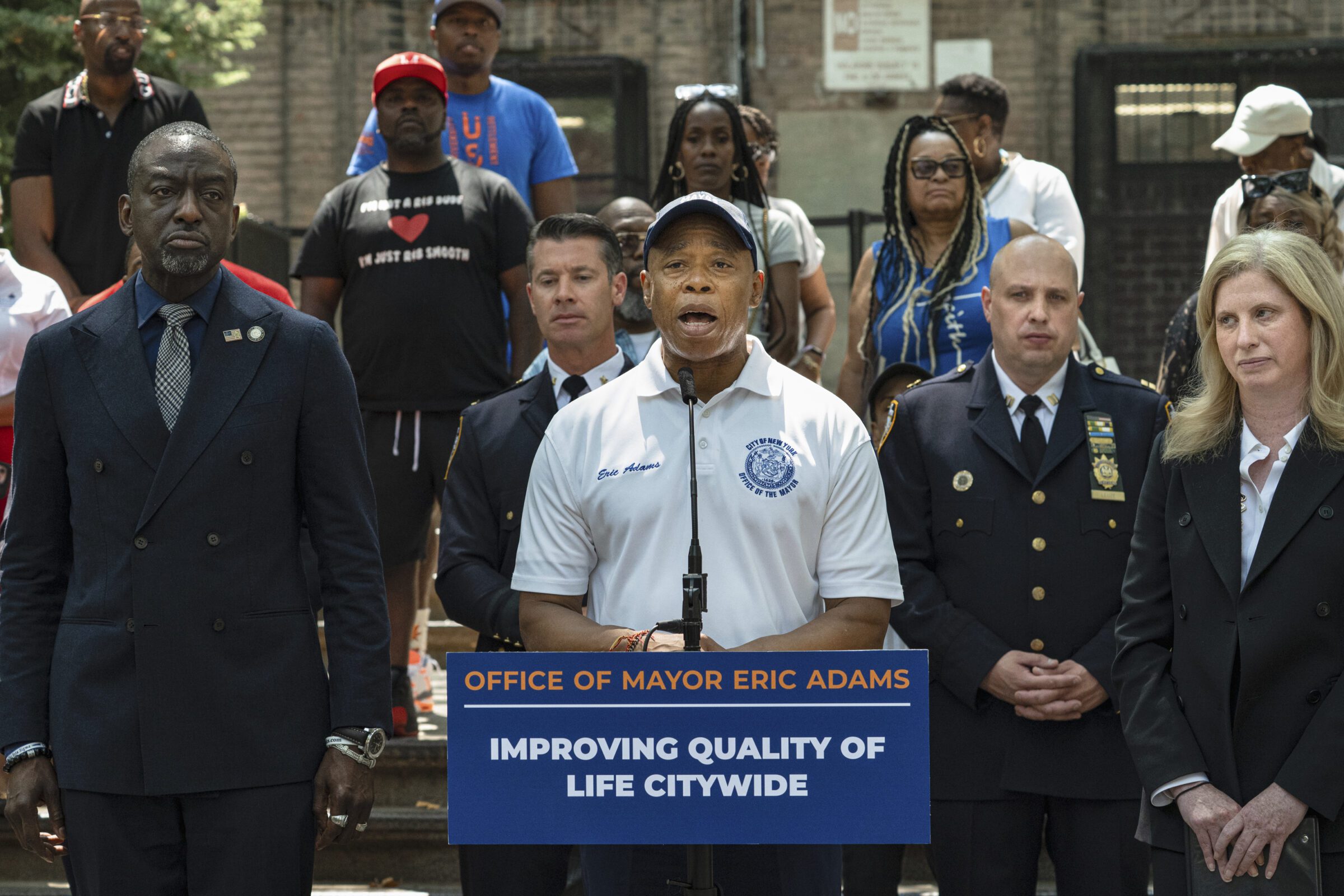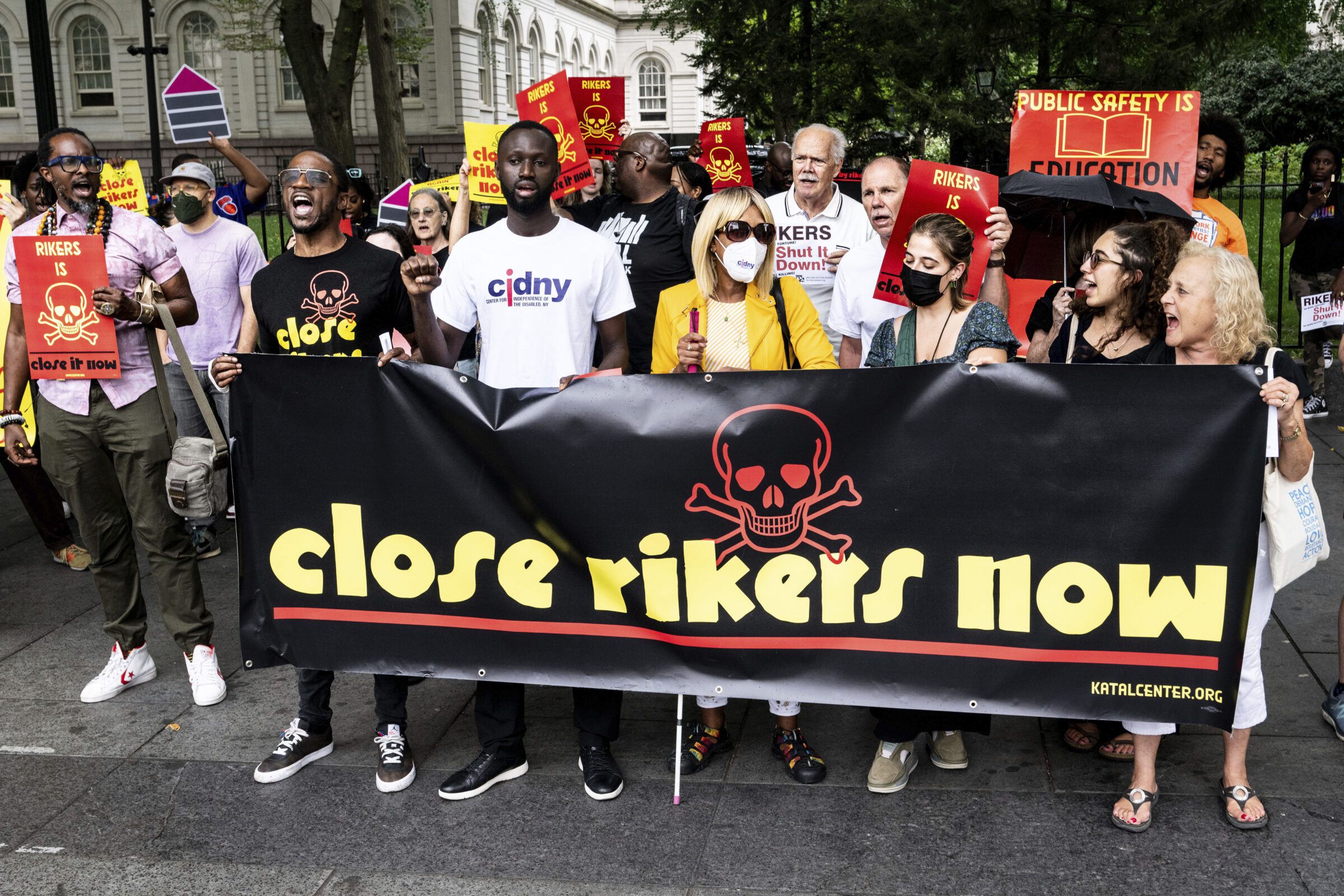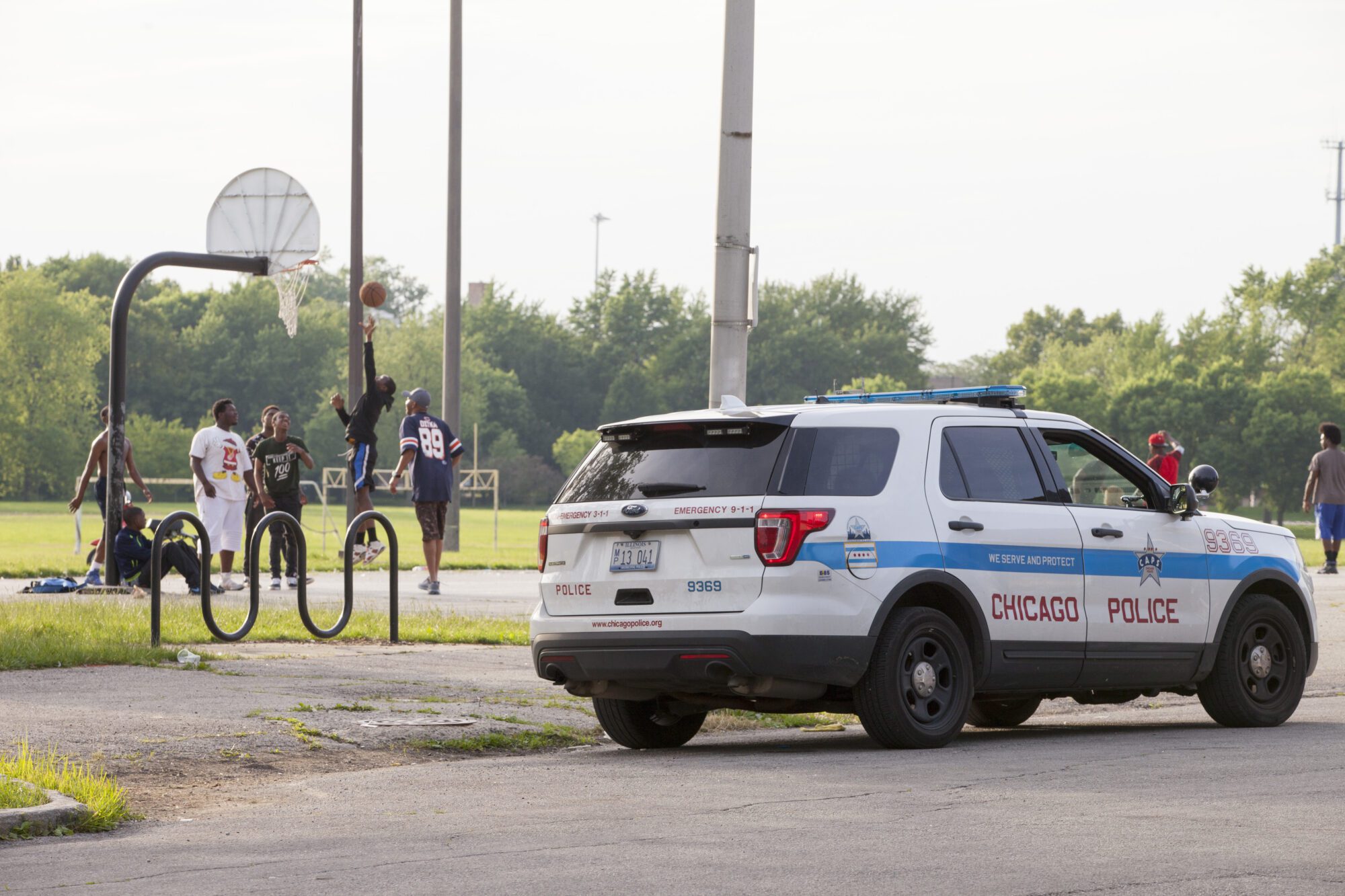Under Eric Adams, the NYPD Sharply Increases Tickets for Low-Level Infractions
New York City’s outgoing mayor has directed police to issue more civil summonses, sparking concerns the practice is undermining a city reform. Will the next mayor take a different path?
| October 30, 2025

This article is part of our coverage of law enforcement issues in the municipal races of 2025. Read our stories on Minneapolis and Seattle.
In the waning months of Eric Adams’ tenure as mayor of New York, now that he has suspended his re-election bid, questions are already swirling around what policies (and scandals) will define the legacy of his single term. Among his signatures has been an increased reliance on policing as a primary tool of public safety, and especially a crackdown on ‘quality-of-life’ violations; low-level breaches of the social contract that often garner complaints from other members of the public. Under Adams, the New York Police Department has leaned on criminal and civil summonses to ticket people for violations ranging from staying in the park after hours to public urination.
New analysis of public data by Bolts shows that civil summonses increased dramatically under Adams. NYPD issued more than 90,000 civil summonses for minor infractions in 2024, nearly three times the number from 2019, the last year before the Covid-19 pandemic, when Bill de Blasio was mayor. That year, police issued just over 11,000 civil summonses.
This has translated to a substantial jump in fines issued by the city related to summonses. In 2024 alone, the city issued at least $2.3 million in fines through NYPD civil summonses, nearly double the previous year—though the city’s ability to collect those fines has been a different story.
The data also suggest that Black and Latinx communities remain disproportionately affected by the NYPD’s crackdown through civil summonses.
“It’s being used in neighborhoods that are traditionally overpoliced, because that’s where the police are, and that’s where they’re using their discretion the most to enforce these kind of low level offenses,” said Jennvine Wong, a supervising attorney with the Legal Aid Society’s Cop Accountability Project.
While Adams has been unequivocal about his belief in policing as a primary public safety strategy, it’s less clear how the next mayor will approach the issue, and how they would handle the use of civil summonses especially. Frontrunner and Democratic nominee Zohran Mamdani has previously said he wants to move NYPD enforcement from low-level offenses to serious crimes. But the candidate has recently walked back some of his criticism of the department as New York City’s mayoral election gets underway.
Summonses are tickets issued by NYPD or another city enforcement agency requiring a person to appear before a civil court judge and pay a fine for violations of certain rules, laws, and regulations in New York City. The types of summonses issued by police include unlawful bicycle riding, selling without proper licensing, and more.
For many years, five offenses in particular carried harsher punishment: Public consumption of alcohol, park rule violations, unreasonable noise, littering or spitting, and public urination, though all non-violent offenses, were often met with criminal summonses that could send an individual to criminal court, where people could face higher fines, possible incarceration, and a criminal record.
For more stories on policing, subscribe to our newsletter
By 2015, the NYPD issued over 150,000 criminal summonses annually for these five offenses, the majority of which disproportionately targeted Black and Latinx communities. In an effort to curb these summonses and reduce the number of open warrants issued for low-level complaints, New York’s city council in 2016 passed the Criminal Justice Reform Act. The legislation directed (but did not require) agencies to issue only civil summonses for these offenses in most instances, moving the violations back into civil court where consequences are less severe.
The Criminal Justice Reform Act was largely hailed a success for its impact at reducing the number of criminal summonses issued in New York City; within a year of the law’s passage, these summonses were down 90 percent from the year prior.
“For civil summonses, warrants or jail time cannot be imposed…so it prevents a much more serious potential outcome,” said Anna Stenkamp, a senior research associate at John Jay College’s Data Collaborative for Justice (DCJ). Stenkamp has researched criminal and civil summonses issued by the NYPD after the CJRA’s passage through a private data-sharing agreement with the city’s Office of Administrative Trials and Hearings (OATH), the city agency that processes civil summonses issued by various enforcement agencies.
But now nearly ten years on from the bill’s passage, as civil summonses have grown substantially, some observers are concerned that police are using civil summonses in a way that undercuts the spirit of the reform law. Excessive use of civil summonses, they argue, has still entangled thousands of New Yorkers in the city’s justice system, and has obscured a need for deeper systemic reforms. (Criminal summonses saw an increase as well in the first years of the Adams administration, before declining again in 2024.)
Stephen Koppel, another senior research associate at DCJ, says they have seen the number of civil summonses “sort of exploding” since CJRA. “Maybe one way to cast that is some sort of net-widening effect, where they are lowering the threshold by predominantly issuing civil summonses, but doing it at much higher rates.”
“It’s just very frustrating, because there was a lot of hard work that was put into that, a lot of thought into trying to look at policies that we could implement as a city to try to create more fairness, more justice, and try to deal with those inequalities that exist in systems that have been historically set up in a way that eventually harm our communities,” Melissa Mark-Viverito, the former New York City Council speaker who championed the CJRA’s passage, told Bolts.
Michael Sisitzky, assistant policy director for the New York Civil Liberties Union points out that even these less punitive summonses still have consequences. “There’s still an encounter with the law enforcement officer, there’s still someone who is potentially facing having to pay a fine they may be struggling to afford, and there’s still the inherent biases of we’re relying on law enforcement to do a lot of this enforcement.”
Sizitsky said that the increase in NYPD summonses hearkens back to the administration of Mayor Michael Bloomberg, who embraced “broken windows” policing, a disproven strategy that targets minor offenses out of a belief that doing so prevents people from committing larger, more serious crimes in the future.
Adams, a longtime NYPD officer before campaigning for public office, has also adopted this strategy more broadly, from recently expanding new dedicated “quality-of-life” police teams alongside NYPD Commissioner Jessica Tisch, to increasingly using controversial police tactics such as stop-and-frisks and traffic stops. His crackdown has brought in other city agencies, including the Department of Sanitation, which Adams has touted for its increased enforcement. Adams’ office did not respond to Bolts’ request for comment on his administration’s use of civil summonses.
Civil summonses typically come with fines ranging from $25 or less all the way to $1,000 or more, depending on the offense. Yearly fines issued by the city have ballooned commensurate with the increase in civil summonses issued under Adams. But despite the city’s increased enforcement, it isn’t raking in cash—indicating a large number of people who can’t or won’t pay.
A Bolts analysis of publicly available OATH data showed that thousands of people issued civil summonses by the NYPD still owe outstanding fines to the city. Though compliance rates have generally increased from the years before the pandemic, the number of people who haven’t paid penalties or otherwise completed the terms of their summonses remains high. As civil summonses have increased, so too has the number of people defaulting on payments—though the overall percentage of people complying remains higher than pre-pandemic years.
Leaving fines unpaid can cut people off from documentation issued by the city. “You might lose your ability to…[acquire] a vendor license or, for example, you might lose your ability to keep or get one of those city licenses or permits or registrations,” Wong said. The city issues permits for everything from firearms to real estate brokerage. This could affect a person’s livelihood, especially if they need city permits to conduct business.
Unpaid fines could also be sent to a collection agency, or the city could pursue a judgment through civil court. “The court could order penalties, interest or additional fees, and it could lead to really severe consequences in the end, like wage garnishment,” Wong said. Accumulating three or more civil summonses can also lead to the NYPD issuing criminal summonses for future violations, per the NYPD patrol guidebook.
While the city started providing people with the option to do online community service hours in lieu of paying fines for certain violations in 2020, Wong noted it could still be burdensome. The service hours require people to complete an e-learning module and video, though in some cases people may have to complete on-site community service. “You have to take the time out to go do that,” Wong said. “For folks who are working more than one job, or who may have other impediments to them, it just doesn’t make any sense.”
Black and Latinx people have consistently made up over 50 percent of those issued civil summonses by the NYPD in recent years, according to NYPD public data. They also made up over 50 percent of those who defaulted on hearings in 2022, according to Stenkamp and Koppel. OATH public data doesn’t include the race or ethnicity of individuals issued summonses, but the two researchers received default data that included ethnicity and racial categories for respondents through their organization’s private data-sharing agreement with OATH.
In 2024, though the NYPD issued almost $2.3 million in civil summonses, with over a quarter of all people defaulting on payment, that translated to only $868,000 in NYPD-issued civil summonses brought into city coffers. An OATH spokesperson told Bolts via email that CJRA civil summonses that have been fully addressed are not included in the online database. “If the summonses had gone to criminal court and been correctly addressed/resolved, the record would be sealed by the criminal court,” OATH deputy commissioner Marisa Senigo wrote. “So the same confidentiality is afforded to those who are charged with the same infraction but as a civil offense and given a summons returnable to OATH.” But even with these summonses removed from the database, it still provides monetary baselines for how much the city is charging in fines, and what they’re bringing in.
“While city enforcement agencies have increased the volume of summonses filed with OATH in recent years, OATH has continued to fulfill its mission to issue fair, impartial, and timely decisions,” Senigo wrote. Senigo’s words point to what has become a feature of the Adams administration: a gradual increase of civil summonses processed by OATH. City agencies issued over 930,000 summonses last year alone—up from the roughly 810,000 summonses per year they used to hover around pre-pandemic.
With Adams and his policing strategies soon out of the picture, attention has turned to how New York City’s remaining mayoral candidates plan to treat policing. In the race between Republican longshot Curtis Sliwa, Andrew Cuomo, who’s running as an independent, and Democratic nominee Mamdani, each has picked a different lane on public safety.
In his public safety plan, Cuomo wrote that his administration would “crackdown on nuisance and quality-of-life crimes.” Sliwa has also written that his administration would “enhance proactive and intrusive policing strategies” and “challenge activist-driven policies that put criminals above law-abiding citizens.”
Mamdani, the self-styled democratic socialist and frontrunner in the race, has been somewhat opaque on the issue of policing and public safety throughout his campaign. Formerly a fierce critic of the NYPD, Mamdani has in recent days apologized for his past comments, has said that he would keep police staffing at current levels if elected, and said he would also keep Jessica Tisch as NYPD commissioner.
But he has also put forth a different plan to address public safety that’s focused on strengthening social safety net policies as a means of crime prevention. His plan includes the creation of a $1.1 billion Department of Community Safety that will implement “evidence-based strategies” to address crime, and redirect some functions like mental health crisis response away from police. His platform has also centered on lowering the cost of living. Neither Mamdani, Sliwa, nor Cuomo have responded to Bolts’ requests for comment regarding the usage of civil summonses by the NYPD and other city departments.
Sizitsky said that regardless of who the mayor is, continuing to issue civil summonses doesn’t address underlying issues that prompt them. “If one of the issues that we’re trying to address is public urination in the streets, maybe we actually should look at investing in the creation of more public restrooms that are accessible.”
“It takes more time, more effort, to do those longer term investments, but that’s going to ultimately meet people’s needs without just relying on enforcement in the back end to try to scare people into compliance, [when] what they actually just need is an accessible restroom,” he continued
While Sizitsky said the diversion of the CJRA offenses to civil courts was a step forward, he believes the next step needs to be reducing avenues of enforcement against city residents—including through civil summonses.
“A lot of the people who receive these summonses very commonly are living on the street or homeless,” Dan Bodah, a New York City-based criminal justice researcher, said. “Most of their activities of daily life, by necessity, take place on the streets. If they drink beer—that’s an open container in public [violation]. If they have to urinate, it’s often difficult for them to access bathrooms. If they are in the park after dark, it’s because they’re unhoused and the park is a place with space to go to.”
“So a lot of those violations, it’s really unclear whether a criminal or civil summons makes any difference in that person’s material situation,” he said.
Sisitzky echoed Bodah’s comments. “What they’re actually doing is making quality of life that much more fearful for a lot of communities that have long been marginalized, long been targeted, and need investments in infrastructure,” he said. “Not just more fines, more summonses and more contact with the criminal legal system.”
Sign up and stay up-to-date
Support us
Bolts is a non-profit newsroom that relies on donations, and it takes resources to produce this work. If you appreciate our value, become a monthly donor or make a contribution.




